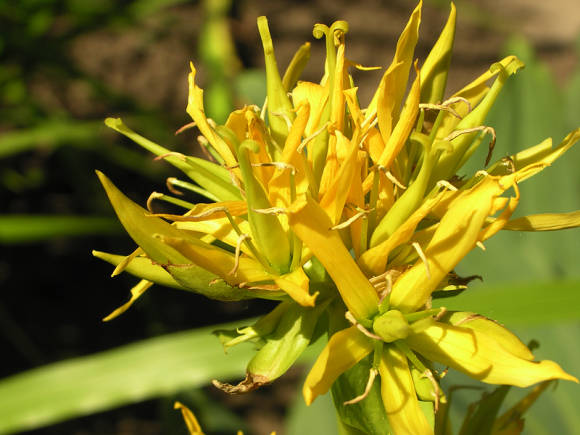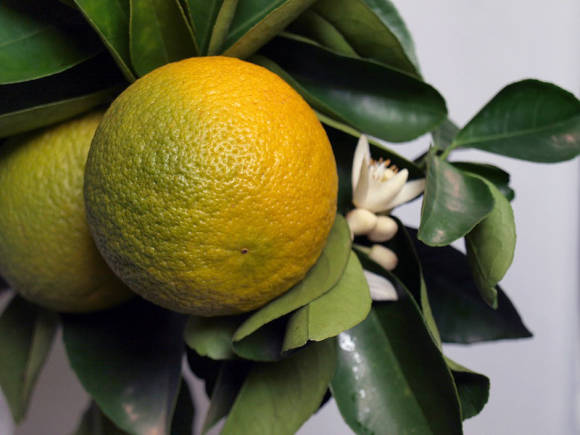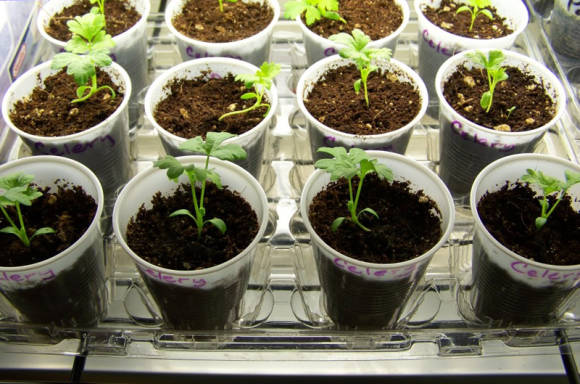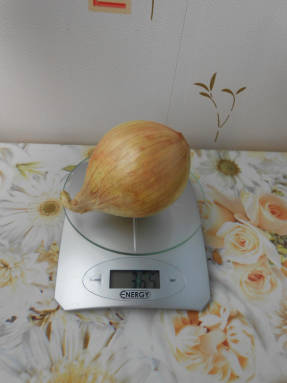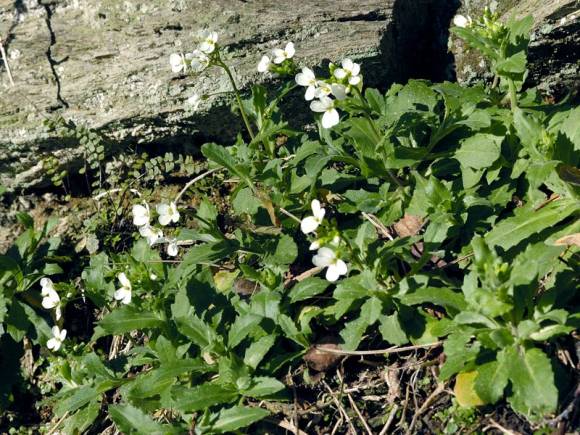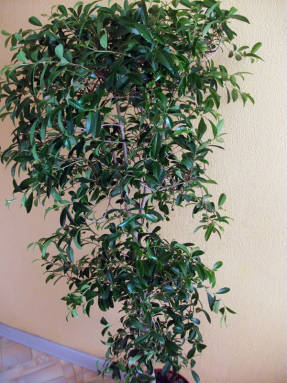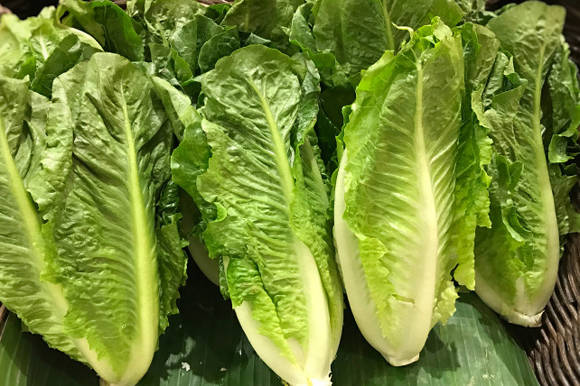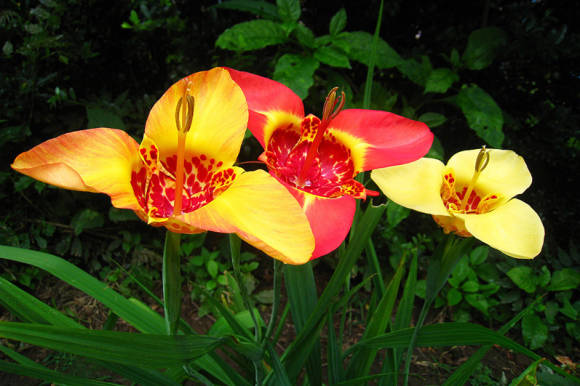The violet has a rich and beautiful past. This modest adorable spring flower was loved in all European countries by kings, poets, and common people. In France, in the vicinity of Nice and in Northern Italy near Parma, for a long time, fragrantParma violet, which was used in perfumery to produce expensive perfumes.
 |
But all this, one might say, is in the past. And then the fashion for violets passed, and they were forgotten for several reasons: at the beginning of the twentieth century, the fashion for African Saintpaulias came to Europe, and large flower producers switched to growing and selling them. With the development of chemistry in the perfume industry, natural violet oil began to be replaced by cheaper chemical substitutes, and the industrial value of violets fell.
One of the first in Europe was the fragrant violet, then the mountain violet. In ornamental gardening, violets are currently most common: fragrant (Viola odorata), horned (Viola cornuta), labrador (Viola labradorica), nursing (Viola sororia) and modern hybrids. Florists love to grow Pansies, the scientific name of which is Vitrokka violet (Viola x wittrokiana).
Fragrant violet (Viola odorata)
Fragrant violet- the most famous of the violets, but when planting it you need to remember that it is somewhat aggressive. It is recommended to plant this violet where there are no delicate delicate plants nearby, which it can displace, actively seizing the living space.
Fragrant violet has long been grown in southern Europe to obtain essential oil, which has a steady demand in perfumery, special varieties 'Parma' and 'Victoria' were bred. Even in our country, at one time, they created plantations for their cultivation on the Black Sea coast of the Caucasus and in the Crimea. Violet essential oil is still used in very expensive perfumes.
Earlier, quite a few garden varieties and forms with yellow, white and pink flowers were bred, the most famous and extant ones: Alba, Christmas, Czar, De Toulouse, Konigin Charlotte, Mrs. R. Barton, Red Charme.
 |  |
To date, nurseries are actively engaged in the search and restoration of old varieties and selection of new ones. In particular, a new interesting variety series has recently appeared called Miracle - Miracle (V. odorata Miracle), which has more intense flowering and larger flowers than other fragrant violets: Miracle White (V. odorata Miracle White), Miracle Blue (V. odorata Miracle Blue), MiracleEd(V. odorata Miracle Red). The varieties are decent, live well and winter in the middle lane, quite worthy bordering mixborders.
 |
Violet parma
Violet Parma does not occur naturally. Its origin remained unclear for a long time. The results of the latest studies carried out at the genetic level, and published in 2007, allow us to say that the Parma violet is a hybrid Viola alba subsp. dehnhardtii (Eastern Mediterranean and Western Asia). The parent plants, most likely of Turkish origin, were introduced to Italy in the Naples region and hybridized with local species. By the beginning of the 19th century, Parma and Toulouse became the centers of its cultivation. Famous varieties: Comte de Brazza - white; Duchess de Parma (Duchess of Parma) - lavender blue; Gloire de Verdun - dark lavender Marie Louise - blue Parme de Toulouse - lavender blue.
 |
Flowering once, in spring. Parma violets have rather large double flowers and shiny leaves. But their most important quality is a wonderful aroma, which brought these plants worldwide fame. Violet Parma reproduces only vegetatively; at present, it is reproduced on an industrial scale by the meristem. As delicate plants of 6-7 winter hardiness zones, they are recommended to be grown as potted plants in small containers in a well-drained substrate. In the summer, they are taken out into the garden in a shaded place, and they winter at home.If you are a big fan, you can try to grow a Parma violet in this way in the middle lane, there is only one problem - to find real varieties. Since September, violets are recommended to be regularly fed with complex fertilizer. With proper care, they should bloom from late fall to early spring.
Several years ago I bought three varieties of Parma violets: Comte de Brazza, Duchesse de Parma, Marie Louis. Knowing nothing about the growing area, I planted them in the garden on the south side, covered them with spruce branches for the winter, and apple leaves fell from above. For two years the violets overwintered quite successfully, with Duchesse de Parma better than Comte de Brazza. These violets did not make a special impression on me: the flower is small, because of this, you can hardly see the terry, and there is no special smell either. I don’t take home for the winter, I’m conducting an experiment on survival.
 |
Then a violet called Parma appeared in my collection. It turned out that this is an amazingly beautiful plant with rounded green leaves, very graceful rather large flowers, the petals of which bend beautifully. Blooms in the second half of May, "spreading" of the curtain is moderate. In the garden, he quickly creates a beautiful blue rug. Self-seeding does not. It is clear that this is an impostor, she is not at all Parma, but she became an adornment of the spring garden and took a worthy place among her sisters. It hibernates well too. Does not bloom again in autumn.
We often hear disappointed reviews that in fact fragrant violets practically do not smell. I compare all the smells with the delicate beautiful spring scent of the splayed phlox Clouds of Perfume, which blooms in the second half of May. I actually have a pretty good sense of smell. But I don't smell the aroma of a fragrant violet. The smell "does not disappear, appears", as they say in smart publications, it is practically absent. A faint smell of freshness is sometimes present, but clearly does not pull on the sung aroma of fragrant violets. Maybe this is a property of modern breeding methods or is the fragrant violet not at all what it claims to be? It is not known for what reason, but the fragrance is absent. However, what difference does it make to us, in the end, when in the spring we so want bright colors after a dull winter.
Horned violet (Viola cornuta)
No less famous is her friend - horned violet. Shegot its name from the spur at the back of the flower that resembles a small horn. This perennial, depending on the variety, has a height of 10 to 20 cm. With a sufficiently small flower size (from 1 to 3 cm), the violet is perfect for creating a flower rug. And my favorite lavender blue variety Bud Blue (Boughton Blue) is a prime example. And they sold it to me without roots, just a twisted spiral, sprinkled with earth. For a couple of years this "something" has turned into a rug of wondrous blue beauty, blooming from the beginning of May until the snow. Arriving to close the roses in November, I was surprised to see this blue miracle blooming after a strong frost, barely warmed by the sun. The violet bloomed on dry land in 2010, when there was no water for irrigation. At the same time, we see a large number of flowers on the bush. And this allows you to have a fairly saturated color spot in a small area.
 |  |
In addition to the Bud Blue variety, today there are many varieties on sale with various colors: in a yellowish range - Ethane (Etain), Lutea Slendens (Lutea Splendens), Rebecca (Rebecca). Rebecca (white-yellowish with a bright blue border) I call zhovto-blakitnaya in the Ukrainian manner. Its color is bright, blooms intermittently, from spring to frost, creeps slightly, but not aggressive, the bushes fall apart a little over time. There is also a pale blue with a yellowish center Ice Bat Spice (Icy but Spicy), light pink Victoria's Blush (Victoria's Blush), purple Martin (Martin), dark purple, almost black Molly Sanderson (Molly Sanderson) and White Perfection White Perfection (White Perfection).
 |  |
In culture, horned violet and hybrid have their own characteristics. Violet horned grows better in a sunny place, shading weakens flowering and makes the plants looser.Violet hybrid prefers moderate temperatures, therefore it is recommended to use it in partial shade, or in combination with higher plants that protect from overheating.
Violet sister, or moth grows best in partial shade on loose, fertile soil. Violet spreads, but rather weakly, not aggressive. There is one small nuance in agricultural technology: it has cleistogamous flowers, i.e. fertilization takes place inside a non-opening bud, and if they are not removed in time, the violet can turn into a malicious weed, scattering throughout the garden. In addition to the main species with lilac flowers, there is also a white form Viola sororia f. albiflora... Albiflora flowers are white with a blue neck, much larger than those of the main species. Long flowering, compact bushes, slowly growing. There are bright hybrid varieties - Rubra (Rubra) - purple-red, and freckle varieties: Freckles (Freckles) - light with purple specks of different sizes and intensities, Duck Freckles (Dark Freckles) - light blue with even darker specks. The variety has recently appeared on sale Hungarian Beauty (Hungarian Beauty - Hungarian beauty), like an enlarged copy of the Albiflora variety - white with a large dark blue dusting in the center. Sister violet is resistant and winter-hardy in central Russia. She is more suitable for partial shade or at least shading from taller plants. If necessary, the curtains can be divided in early spring or autumn. With new hybrid varieties, you need to be careful when planting, producers sometimes incorrectly indicate the species from which the hybrid originates. Several years ago, hybrid varieties appeared on the market. Siletta (Syletta) and Sylvia Hart (Sylvia Hart), which suppliers called Korean violet hybrids. These were varieties with beautiful silvery patterned leaves. The specific Korean violet is a forest plant that loves shade and moisture, so growers planted new items in the shade and partial shade, as expected. And the plants died happily. It turned out that these are hybrids of variegated violets that live on dry sunny slopes. Thanks to Tatyana Konovalova and Natalia Shevyreva, they clarified the situation in their article. Other varieties such as Mars (Mars), Harttrobe (Heartthrob), Dancing Geisha (Dancing Geisha), Silver Samurai (Silver Samurai) really needs to be grown in partial shade. Mars has a dark purple pattern on the leaves, lilac flowers hide under the leaves. His brother Harttrobe (V. coreanaHeartthrob - smoothie) more spectacular, lavender flowers, beautiful dark green leaves with a contrasting burgundy center are especially expressive in spring and autumn. Another pair of Korean varieties - Dancing Geisha and Silver Samurai similar, like close relatives: the leaves are green, strongly dissected, with a silvery pattern along the veins. The flowers are fragrant, pale lilac with wide petals, raised above the foliage. Dancing Geisha - a more elegant variety (only 20 cm in height), Silver Samurai, as befits a courageous man, larger, up to 35 cm, with the same dissected leaf, but with a wavy edge. The beauty of these hybrid varieties is not in the flowers, but in the beautiful leaves. Do not be afraid that they will strangle someone in their arms, these are intelligent not sprawling plants, they grow in the form of separate bushes.
Violet sister, or moth (Viola sororia syn. V. papilionacea)

Korean violet hybrid varieties



